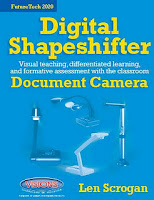As we continue prospecting for 3D gold, here are two more flakes I found in the gold pan as our hot summer came to an end:
A new and promising
stereo-3D educational content producer started exhibiting their wares in the U.S. this summer: e-Animations.
Based in Hungary, this company has a lot to offer, including exceptional
artistry and reasonable pricing. You can preview some of their animations (in
2D) here
on VIMEO.
New Active Glasses for Education
XPAND leaders were in
the aisles and byways at most conferences this summer, visiting various booths and some of
my presentation sessions. They were also showing (in one-off settings) their
latest active glasses for the education market, the EDUX 3 series. These new
glasses offer a TN lens (clearer, with no green tint), CR2032 replaceable
batteries (which can be purchased from any store), folding arms (for better
storage and fit), and an on-off switch. Distances for viewing and durability
remain a high plus for these glasses, and the price has been lowered
significantly from last year. I expect XPAND to remain strong in the education
market with their continuing commitment to continuous improvement and price
reduction.
***
Do you have a new product for the education market or are you updating a previous product? Do you have an interesting story to tell? If so, please contact me for an interview.









